Gibbs' Reflective Cycle: Aboriginal and Torres Strait Islander Health
VerifiedAdded on 2022/10/18
|8
|1963
|26
Essay
AI Summary
This reflective essay, utilizing Gibbs' reflective cycle, examines the author's experiences and reflections on Aboriginal and Torres Strait Islander health within the Australian healthcare system. The essay begins with an introduction to the indigenous population and the health disparities they face, including a discussion on the author's initial lack of knowledge and the importance of nurses in addressing these issues. The essay details a specific incident in a hospital setting where a doctor's discriminatory behavior towards an Aboriginal patient deeply impacted the author. The author explores the historical context of discrimination, the impact of socioeconomic factors on indigenous health, and the role of cultural perspectives in healthcare. The essay analyzes the author's feelings, evaluations, and proposes an action plan to address the identified issues, emphasizing the need for education, training, and advocacy to improve healthcare practices and outcomes for Aboriginal and Torres Strait Islander peoples. The essay also includes references from various sources. The essay concludes by discussing the importance of cultural sensitivity in healthcare and proposes an action plan to address the issues of discrimination and improve healthcare practices and outcomes for Aboriginal and Torres Strait Islander peoples.
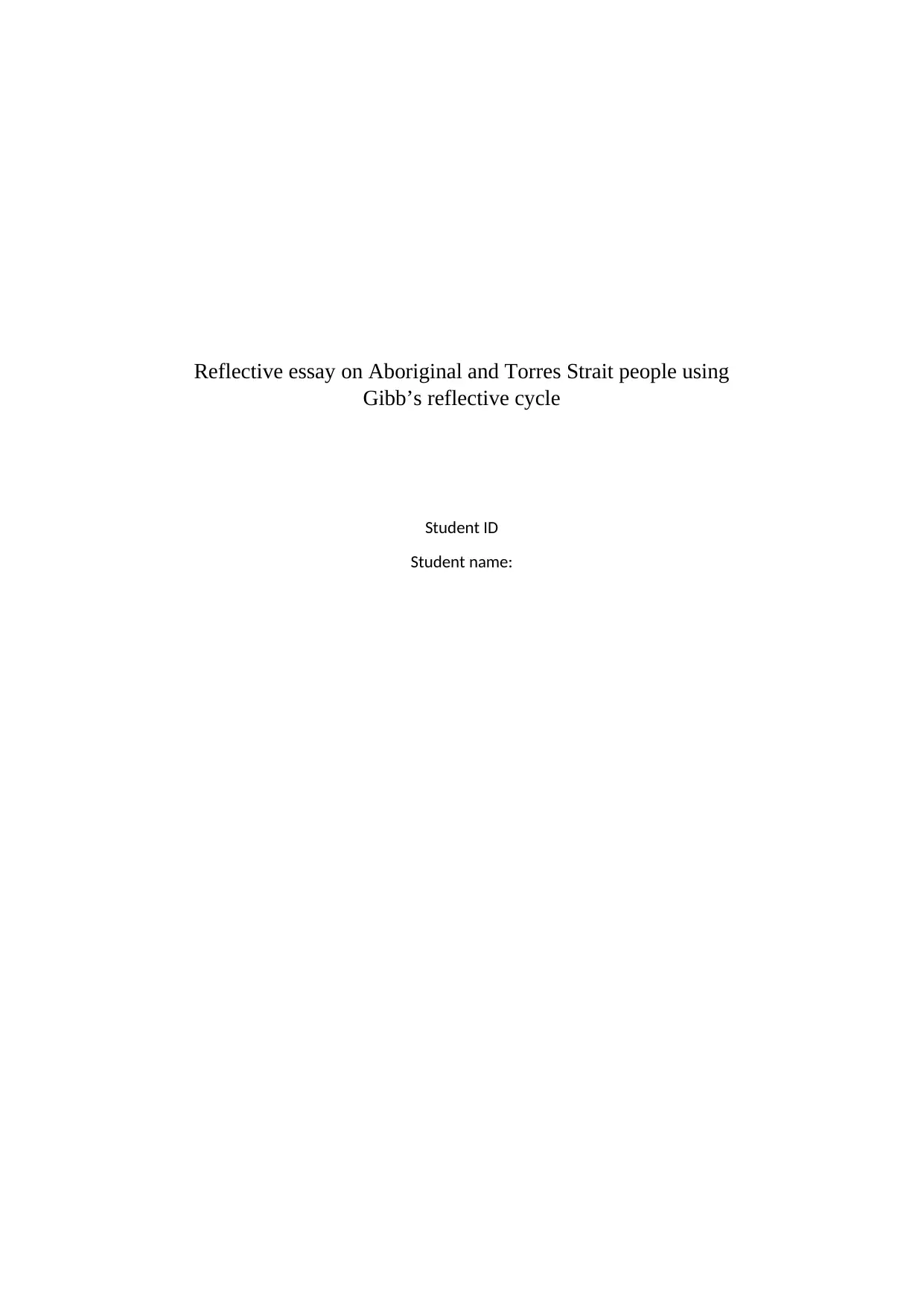
Reflective essay on Aboriginal and Torres Strait people using
Gibb’s reflective cycle
Student ID
Student name:
Gibb’s reflective cycle
Student ID
Student name:
Paraphrase This Document
Need a fresh take? Get an instant paraphrase of this document with our AI Paraphraser
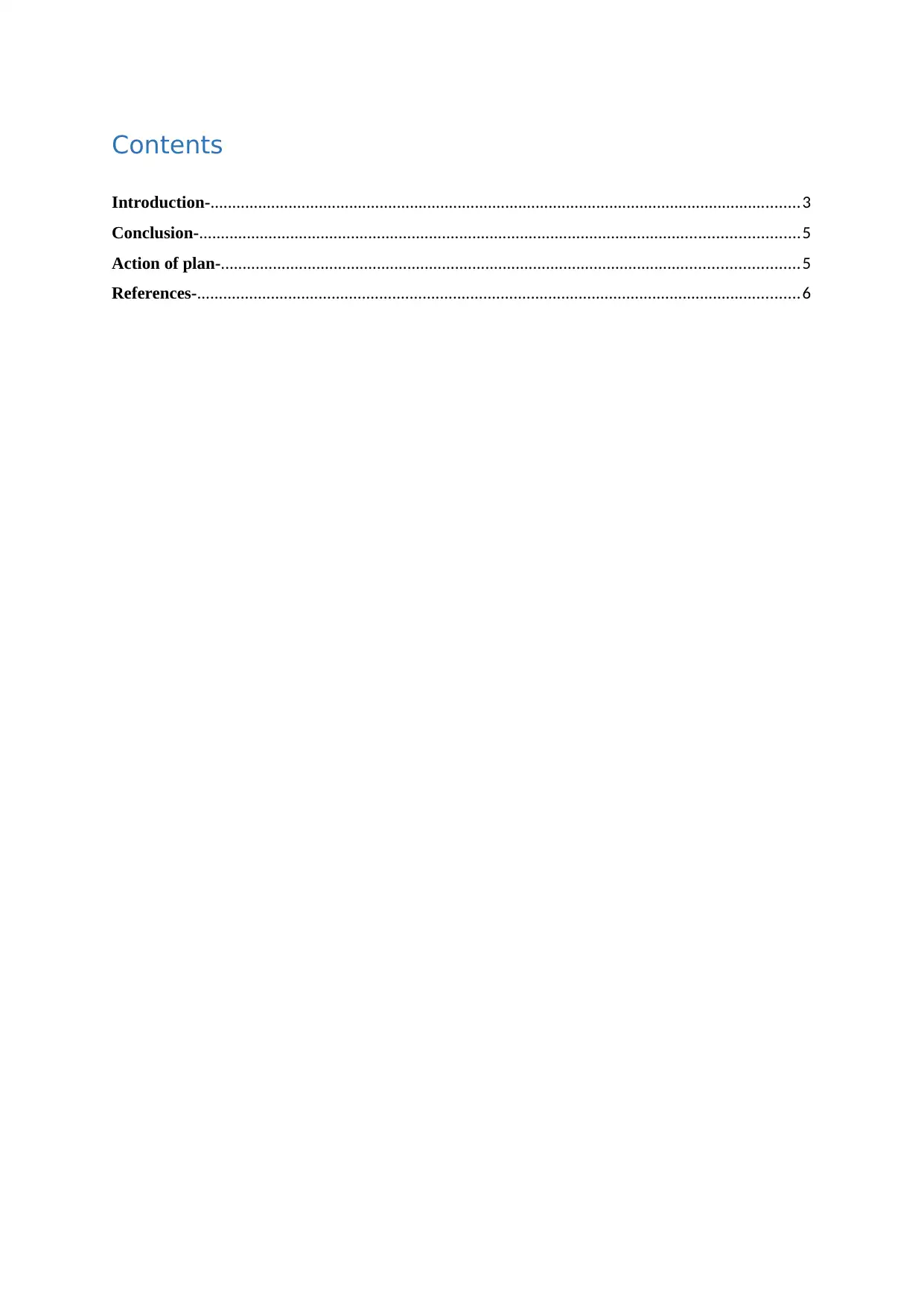
Contents
Introduction-........................................................................................................................................3
Conclusion-..........................................................................................................................................5
Action of plan-.....................................................................................................................................5
References-...........................................................................................................................................6
Introduction-........................................................................................................................................3
Conclusion-..........................................................................................................................................5
Action of plan-.....................................................................................................................................5
References-...........................................................................................................................................6
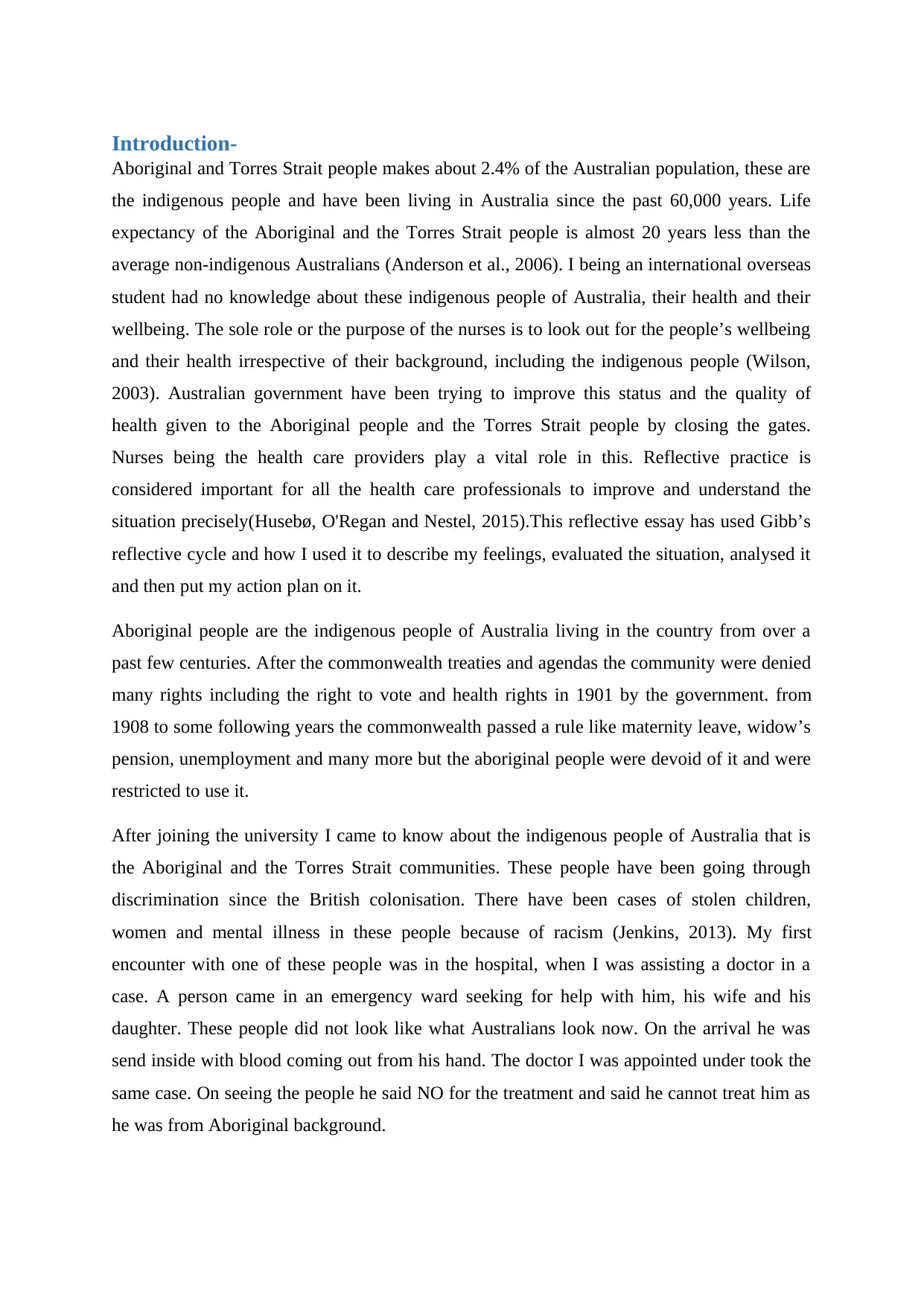
Introduction-
Aboriginal and Torres Strait people makes about 2.4% of the Australian population, these are
the indigenous people and have been living in Australia since the past 60,000 years. Life
expectancy of the Aboriginal and the Torres Strait people is almost 20 years less than the
average non-indigenous Australians (Anderson et al., 2006). I being an international overseas
student had no knowledge about these indigenous people of Australia, their health and their
wellbeing. The sole role or the purpose of the nurses is to look out for the people’s wellbeing
and their health irrespective of their background, including the indigenous people (Wilson,
2003). Australian government have been trying to improve this status and the quality of
health given to the Aboriginal people and the Torres Strait people by closing the gates.
Nurses being the health care providers play a vital role in this. Reflective practice is
considered important for all the health care professionals to improve and understand the
situation precisely(Husebø, O'Regan and Nestel, 2015).This reflective essay has used Gibb’s
reflective cycle and how I used it to describe my feelings, evaluated the situation, analysed it
and then put my action plan on it.
Aboriginal people are the indigenous people of Australia living in the country from over a
past few centuries. After the commonwealth treaties and agendas the community were denied
many rights including the right to vote and health rights in 1901 by the government. from
1908 to some following years the commonwealth passed a rule like maternity leave, widow’s
pension, unemployment and many more but the aboriginal people were devoid of it and were
restricted to use it.
After joining the university I came to know about the indigenous people of Australia that is
the Aboriginal and the Torres Strait communities. These people have been going through
discrimination since the British colonisation. There have been cases of stolen children,
women and mental illness in these people because of racism (Jenkins, 2013). My first
encounter with one of these people was in the hospital, when I was assisting a doctor in a
case. A person came in an emergency ward seeking for help with him, his wife and his
daughter. These people did not look like what Australians look now. On the arrival he was
send inside with blood coming out from his hand. The doctor I was appointed under took the
same case. On seeing the people he said NO for the treatment and said he cannot treat him as
he was from Aboriginal background.
Aboriginal and Torres Strait people makes about 2.4% of the Australian population, these are
the indigenous people and have been living in Australia since the past 60,000 years. Life
expectancy of the Aboriginal and the Torres Strait people is almost 20 years less than the
average non-indigenous Australians (Anderson et al., 2006). I being an international overseas
student had no knowledge about these indigenous people of Australia, their health and their
wellbeing. The sole role or the purpose of the nurses is to look out for the people’s wellbeing
and their health irrespective of their background, including the indigenous people (Wilson,
2003). Australian government have been trying to improve this status and the quality of
health given to the Aboriginal people and the Torres Strait people by closing the gates.
Nurses being the health care providers play a vital role in this. Reflective practice is
considered important for all the health care professionals to improve and understand the
situation precisely(Husebø, O'Regan and Nestel, 2015).This reflective essay has used Gibb’s
reflective cycle and how I used it to describe my feelings, evaluated the situation, analysed it
and then put my action plan on it.
Aboriginal people are the indigenous people of Australia living in the country from over a
past few centuries. After the commonwealth treaties and agendas the community were denied
many rights including the right to vote and health rights in 1901 by the government. from
1908 to some following years the commonwealth passed a rule like maternity leave, widow’s
pension, unemployment and many more but the aboriginal people were devoid of it and were
restricted to use it.
After joining the university I came to know about the indigenous people of Australia that is
the Aboriginal and the Torres Strait communities. These people have been going through
discrimination since the British colonisation. There have been cases of stolen children,
women and mental illness in these people because of racism (Jenkins, 2013). My first
encounter with one of these people was in the hospital, when I was assisting a doctor in a
case. A person came in an emergency ward seeking for help with him, his wife and his
daughter. These people did not look like what Australians look now. On the arrival he was
send inside with blood coming out from his hand. The doctor I was appointed under took the
same case. On seeing the people he said NO for the treatment and said he cannot treat him as
he was from Aboriginal background.
⊘ This is a preview!⊘
Do you want full access?
Subscribe today to unlock all pages.

Trusted by 1+ million students worldwide
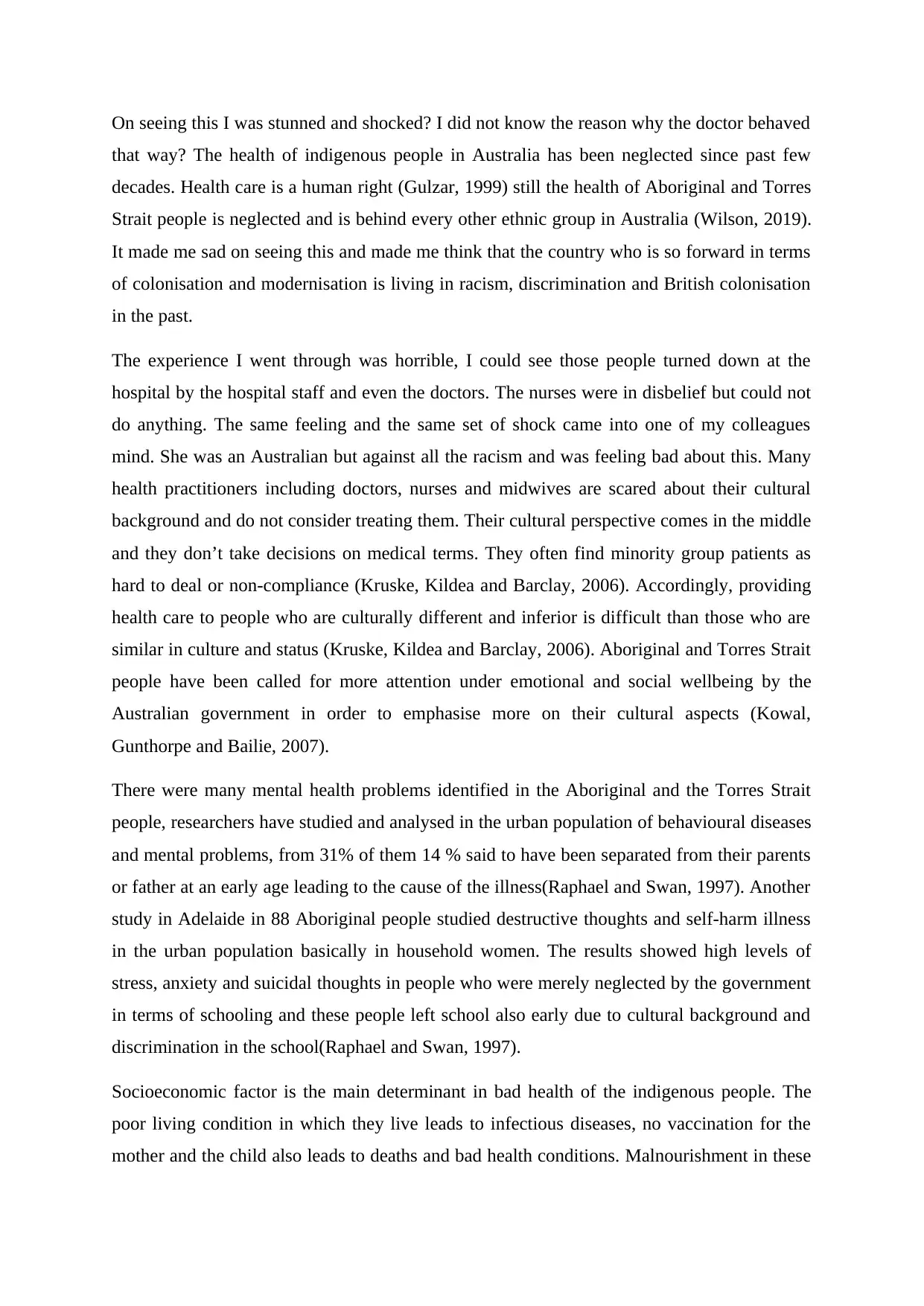
On seeing this I was stunned and shocked? I did not know the reason why the doctor behaved
that way? The health of indigenous people in Australia has been neglected since past few
decades. Health care is a human right (Gulzar, 1999) still the health of Aboriginal and Torres
Strait people is neglected and is behind every other ethnic group in Australia (Wilson, 2019).
It made me sad on seeing this and made me think that the country who is so forward in terms
of colonisation and modernisation is living in racism, discrimination and British colonisation
in the past.
The experience I went through was horrible, I could see those people turned down at the
hospital by the hospital staff and even the doctors. The nurses were in disbelief but could not
do anything. The same feeling and the same set of shock came into one of my colleagues
mind. She was an Australian but against all the racism and was feeling bad about this. Many
health practitioners including doctors, nurses and midwives are scared about their cultural
background and do not consider treating them. Their cultural perspective comes in the middle
and they don’t take decisions on medical terms. They often find minority group patients as
hard to deal or non-compliance (Kruske, Kildea and Barclay, 2006). Accordingly, providing
health care to people who are culturally different and inferior is difficult than those who are
similar in culture and status (Kruske, Kildea and Barclay, 2006). Aboriginal and Torres Strait
people have been called for more attention under emotional and social wellbeing by the
Australian government in order to emphasise more on their cultural aspects (Kowal,
Gunthorpe and Bailie, 2007).
There were many mental health problems identified in the Aboriginal and the Torres Strait
people, researchers have studied and analysed in the urban population of behavioural diseases
and mental problems, from 31% of them 14 % said to have been separated from their parents
or father at an early age leading to the cause of the illness(Raphael and Swan, 1997). Another
study in Adelaide in 88 Aboriginal people studied destructive thoughts and self-harm illness
in the urban population basically in household women. The results showed high levels of
stress, anxiety and suicidal thoughts in people who were merely neglected by the government
in terms of schooling and these people left school also early due to cultural background and
discrimination in the school(Raphael and Swan, 1997).
Socioeconomic factor is the main determinant in bad health of the indigenous people. The
poor living condition in which they live leads to infectious diseases, no vaccination for the
mother and the child also leads to deaths and bad health conditions. Malnourishment in these
that way? The health of indigenous people in Australia has been neglected since past few
decades. Health care is a human right (Gulzar, 1999) still the health of Aboriginal and Torres
Strait people is neglected and is behind every other ethnic group in Australia (Wilson, 2019).
It made me sad on seeing this and made me think that the country who is so forward in terms
of colonisation and modernisation is living in racism, discrimination and British colonisation
in the past.
The experience I went through was horrible, I could see those people turned down at the
hospital by the hospital staff and even the doctors. The nurses were in disbelief but could not
do anything. The same feeling and the same set of shock came into one of my colleagues
mind. She was an Australian but against all the racism and was feeling bad about this. Many
health practitioners including doctors, nurses and midwives are scared about their cultural
background and do not consider treating them. Their cultural perspective comes in the middle
and they don’t take decisions on medical terms. They often find minority group patients as
hard to deal or non-compliance (Kruske, Kildea and Barclay, 2006). Accordingly, providing
health care to people who are culturally different and inferior is difficult than those who are
similar in culture and status (Kruske, Kildea and Barclay, 2006). Aboriginal and Torres Strait
people have been called for more attention under emotional and social wellbeing by the
Australian government in order to emphasise more on their cultural aspects (Kowal,
Gunthorpe and Bailie, 2007).
There were many mental health problems identified in the Aboriginal and the Torres Strait
people, researchers have studied and analysed in the urban population of behavioural diseases
and mental problems, from 31% of them 14 % said to have been separated from their parents
or father at an early age leading to the cause of the illness(Raphael and Swan, 1997). Another
study in Adelaide in 88 Aboriginal people studied destructive thoughts and self-harm illness
in the urban population basically in household women. The results showed high levels of
stress, anxiety and suicidal thoughts in people who were merely neglected by the government
in terms of schooling and these people left school also early due to cultural background and
discrimination in the school(Raphael and Swan, 1997).
Socioeconomic factor is the main determinant in bad health of the indigenous people. The
poor living condition in which they live leads to infectious diseases, no vaccination for the
mother and the child also leads to deaths and bad health conditions. Malnourishment in these
Paraphrase This Document
Need a fresh take? Get an instant paraphrase of this document with our AI Paraphraser
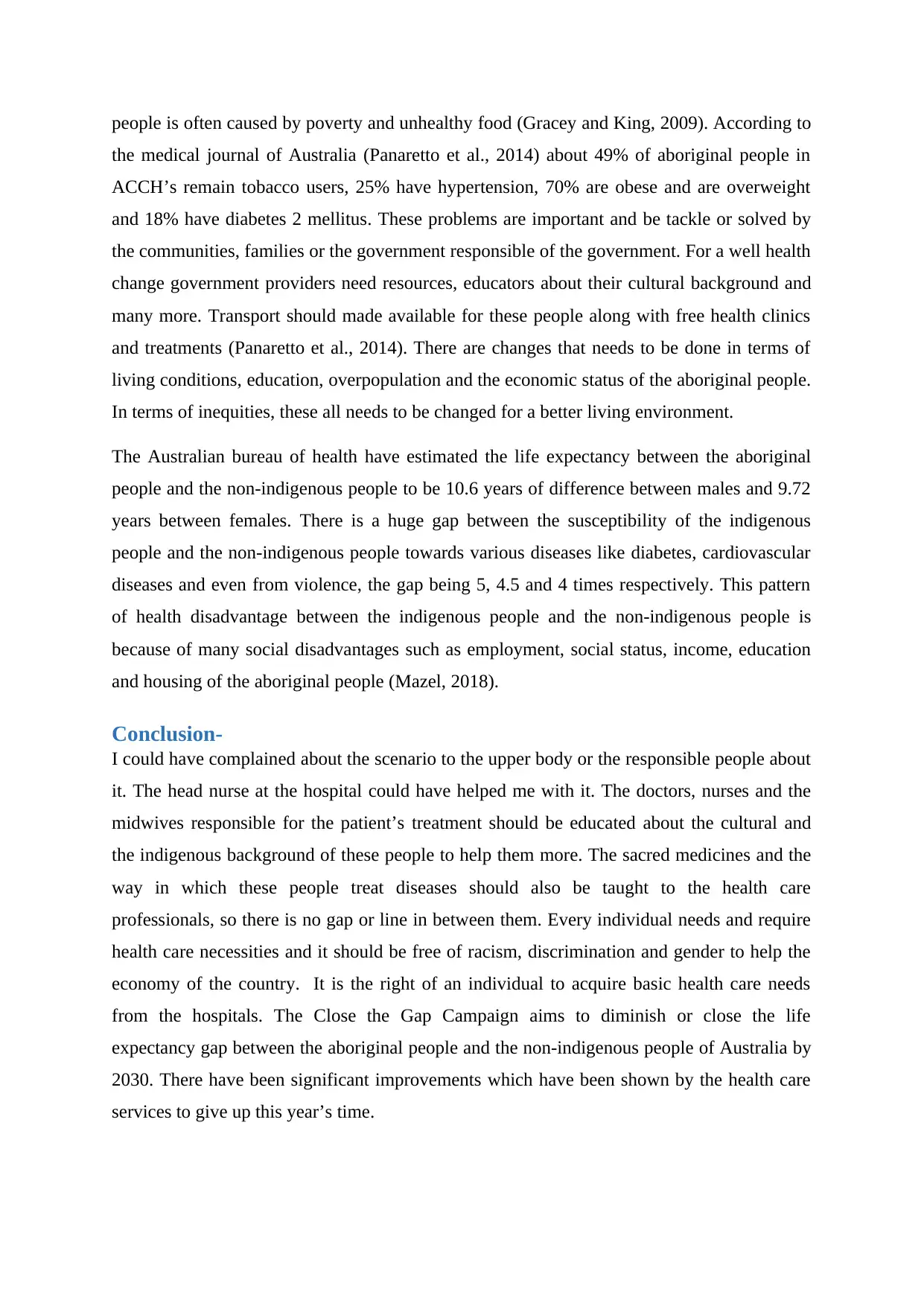
people is often caused by poverty and unhealthy food (Gracey and King, 2009). According to
the medical journal of Australia (Panaretto et al., 2014) about 49% of aboriginal people in
ACCH’s remain tobacco users, 25% have hypertension, 70% are obese and are overweight
and 18% have diabetes 2 mellitus. These problems are important and be tackle or solved by
the communities, families or the government responsible of the government. For a well health
change government providers need resources, educators about their cultural background and
many more. Transport should made available for these people along with free health clinics
and treatments (Panaretto et al., 2014). There are changes that needs to be done in terms of
living conditions, education, overpopulation and the economic status of the aboriginal people.
In terms of inequities, these all needs to be changed for a better living environment.
The Australian bureau of health have estimated the life expectancy between the aboriginal
people and the non-indigenous people to be 10.6 years of difference between males and 9.72
years between females. There is a huge gap between the susceptibility of the indigenous
people and the non-indigenous people towards various diseases like diabetes, cardiovascular
diseases and even from violence, the gap being 5, 4.5 and 4 times respectively. This pattern
of health disadvantage between the indigenous people and the non-indigenous people is
because of many social disadvantages such as employment, social status, income, education
and housing of the aboriginal people (Mazel, 2018).
Conclusion-
I could have complained about the scenario to the upper body or the responsible people about
it. The head nurse at the hospital could have helped me with it. The doctors, nurses and the
midwives responsible for the patient’s treatment should be educated about the cultural and
the indigenous background of these people to help them more. The sacred medicines and the
way in which these people treat diseases should also be taught to the health care
professionals, so there is no gap or line in between them. Every individual needs and require
health care necessities and it should be free of racism, discrimination and gender to help the
economy of the country. It is the right of an individual to acquire basic health care needs
from the hospitals. The Close the Gap Campaign aims to diminish or close the life
expectancy gap between the aboriginal people and the non-indigenous people of Australia by
2030. There have been significant improvements which have been shown by the health care
services to give up this year’s time.
the medical journal of Australia (Panaretto et al., 2014) about 49% of aboriginal people in
ACCH’s remain tobacco users, 25% have hypertension, 70% are obese and are overweight
and 18% have diabetes 2 mellitus. These problems are important and be tackle or solved by
the communities, families or the government responsible of the government. For a well health
change government providers need resources, educators about their cultural background and
many more. Transport should made available for these people along with free health clinics
and treatments (Panaretto et al., 2014). There are changes that needs to be done in terms of
living conditions, education, overpopulation and the economic status of the aboriginal people.
In terms of inequities, these all needs to be changed for a better living environment.
The Australian bureau of health have estimated the life expectancy between the aboriginal
people and the non-indigenous people to be 10.6 years of difference between males and 9.72
years between females. There is a huge gap between the susceptibility of the indigenous
people and the non-indigenous people towards various diseases like diabetes, cardiovascular
diseases and even from violence, the gap being 5, 4.5 and 4 times respectively. This pattern
of health disadvantage between the indigenous people and the non-indigenous people is
because of many social disadvantages such as employment, social status, income, education
and housing of the aboriginal people (Mazel, 2018).
Conclusion-
I could have complained about the scenario to the upper body or the responsible people about
it. The head nurse at the hospital could have helped me with it. The doctors, nurses and the
midwives responsible for the patient’s treatment should be educated about the cultural and
the indigenous background of these people to help them more. The sacred medicines and the
way in which these people treat diseases should also be taught to the health care
professionals, so there is no gap or line in between them. Every individual needs and require
health care necessities and it should be free of racism, discrimination and gender to help the
economy of the country. It is the right of an individual to acquire basic health care needs
from the hospitals. The Close the Gap Campaign aims to diminish or close the life
expectancy gap between the aboriginal people and the non-indigenous people of Australia by
2030. There have been significant improvements which have been shown by the health care
services to give up this year’s time.
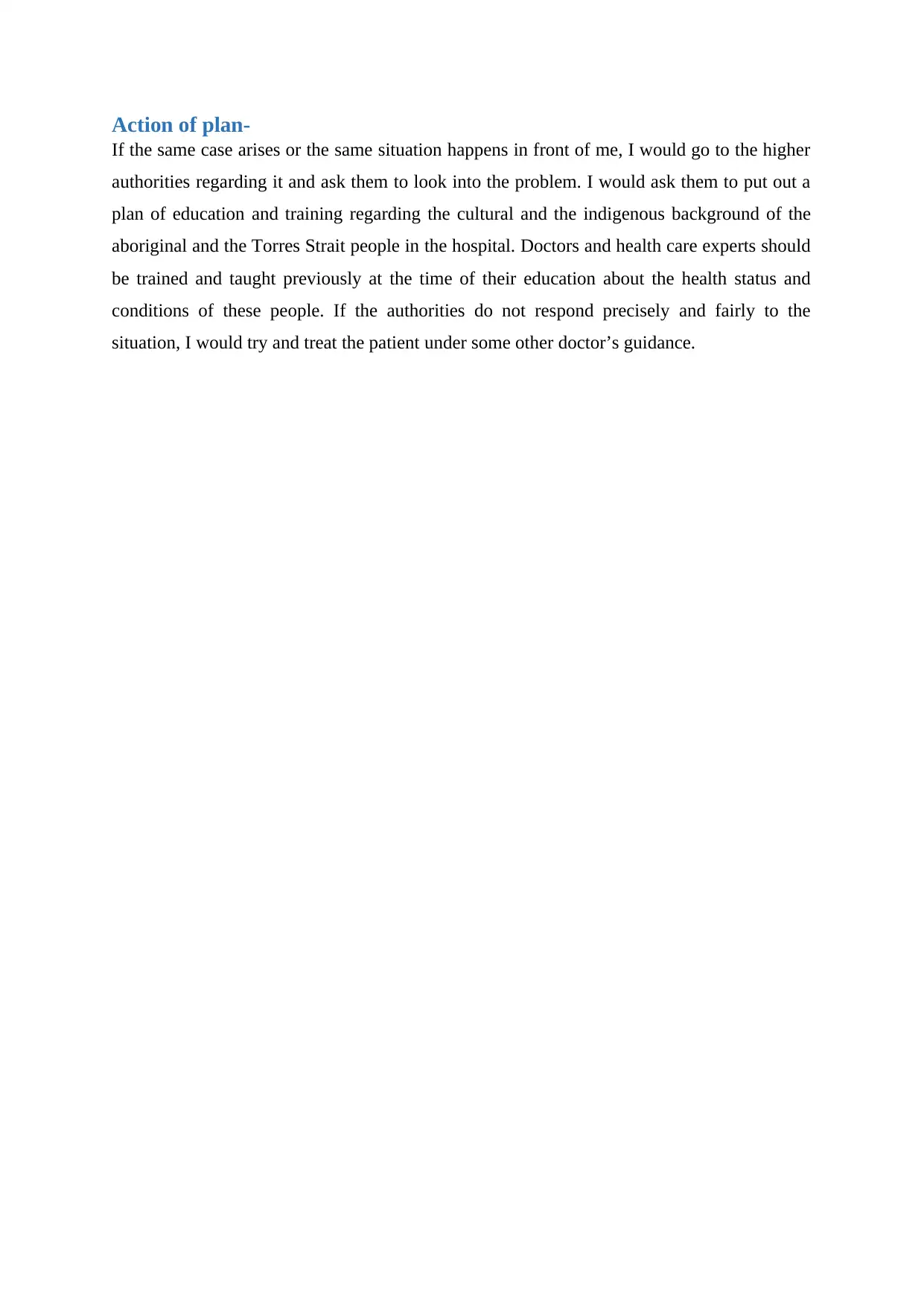
Action of plan-
If the same case arises or the same situation happens in front of me, I would go to the higher
authorities regarding it and ask them to look into the problem. I would ask them to put out a
plan of education and training regarding the cultural and the indigenous background of the
aboriginal and the Torres Strait people in the hospital. Doctors and health care experts should
be trained and taught previously at the time of their education about the health status and
conditions of these people. If the authorities do not respond precisely and fairly to the
situation, I would try and treat the patient under some other doctor’s guidance.
If the same case arises or the same situation happens in front of me, I would go to the higher
authorities regarding it and ask them to look into the problem. I would ask them to put out a
plan of education and training regarding the cultural and the indigenous background of the
aboriginal and the Torres Strait people in the hospital. Doctors and health care experts should
be trained and taught previously at the time of their education about the health status and
conditions of these people. If the authorities do not respond precisely and fairly to the
situation, I would try and treat the patient under some other doctor’s guidance.
⊘ This is a preview!⊘
Do you want full access?
Subscribe today to unlock all pages.

Trusted by 1+ million students worldwide
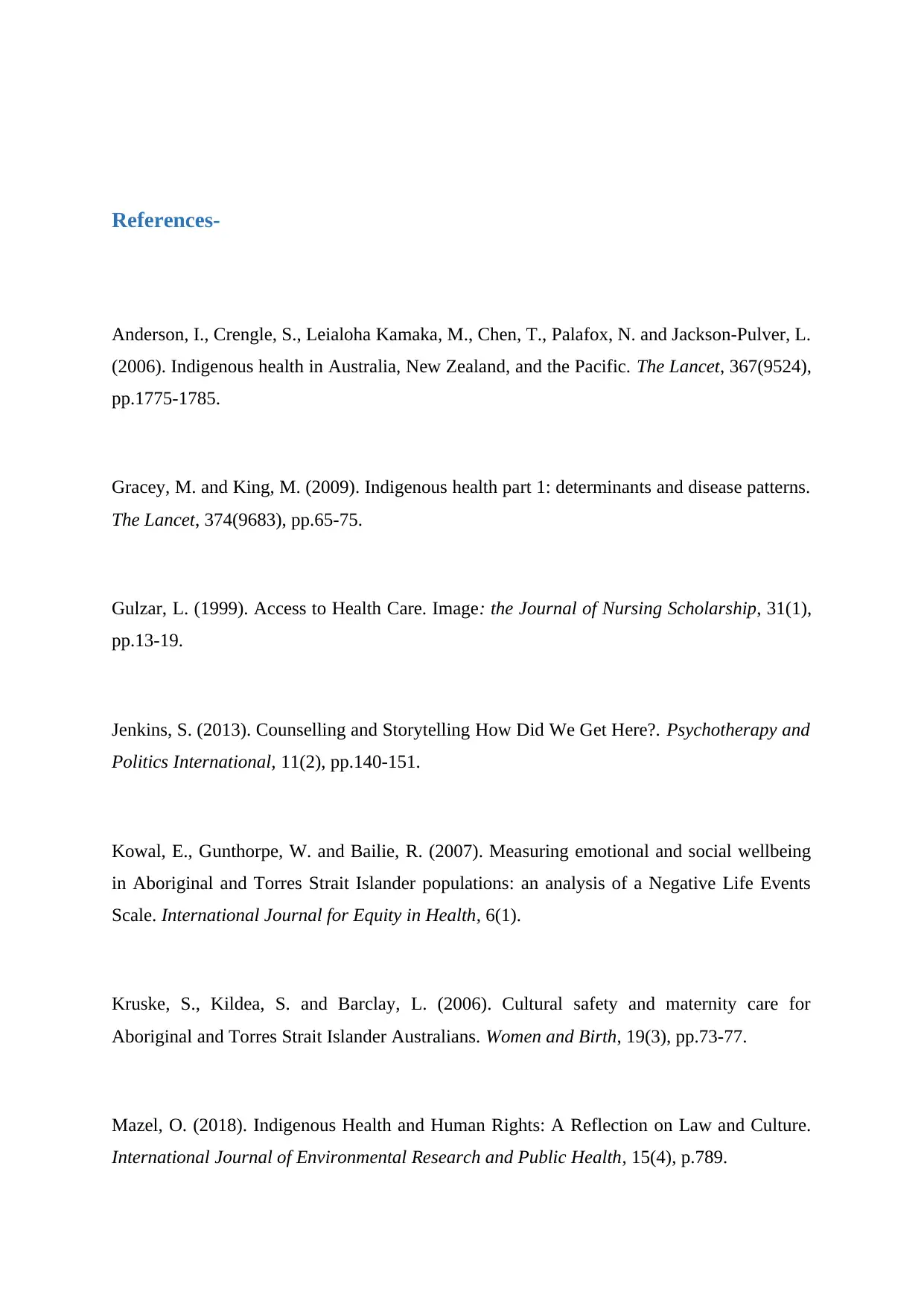
References-
Anderson, I., Crengle, S., Leialoha Kamaka, M., Chen, T., Palafox, N. and Jackson-Pulver, L.
(2006). Indigenous health in Australia, New Zealand, and the Pacific. The Lancet, 367(9524),
pp.1775-1785.
Gracey, M. and King, M. (2009). Indigenous health part 1: determinants and disease patterns.
The Lancet, 374(9683), pp.65-75.
Gulzar, L. (1999). Access to Health Care. Image: the Journal of Nursing Scholarship, 31(1),
pp.13-19.
Jenkins, S. (2013). Counselling and Storytelling How Did We Get Here?. Psychotherapy and
Politics International, 11(2), pp.140-151.
Kowal, E., Gunthorpe, W. and Bailie, R. (2007). Measuring emotional and social wellbeing
in Aboriginal and Torres Strait Islander populations: an analysis of a Negative Life Events
Scale. International Journal for Equity in Health, 6(1).
Kruske, S., Kildea, S. and Barclay, L. (2006). Cultural safety and maternity care for
Aboriginal and Torres Strait Islander Australians. Women and Birth, 19(3), pp.73-77.
Mazel, O. (2018). Indigenous Health and Human Rights: A Reflection on Law and Culture.
International Journal of Environmental Research and Public Health, 15(4), p.789.
Anderson, I., Crengle, S., Leialoha Kamaka, M., Chen, T., Palafox, N. and Jackson-Pulver, L.
(2006). Indigenous health in Australia, New Zealand, and the Pacific. The Lancet, 367(9524),
pp.1775-1785.
Gracey, M. and King, M. (2009). Indigenous health part 1: determinants and disease patterns.
The Lancet, 374(9683), pp.65-75.
Gulzar, L. (1999). Access to Health Care. Image: the Journal of Nursing Scholarship, 31(1),
pp.13-19.
Jenkins, S. (2013). Counselling and Storytelling How Did We Get Here?. Psychotherapy and
Politics International, 11(2), pp.140-151.
Kowal, E., Gunthorpe, W. and Bailie, R. (2007). Measuring emotional and social wellbeing
in Aboriginal and Torres Strait Islander populations: an analysis of a Negative Life Events
Scale. International Journal for Equity in Health, 6(1).
Kruske, S., Kildea, S. and Barclay, L. (2006). Cultural safety and maternity care for
Aboriginal and Torres Strait Islander Australians. Women and Birth, 19(3), pp.73-77.
Mazel, O. (2018). Indigenous Health and Human Rights: A Reflection on Law and Culture.
International Journal of Environmental Research and Public Health, 15(4), p.789.
Paraphrase This Document
Need a fresh take? Get an instant paraphrase of this document with our AI Paraphraser
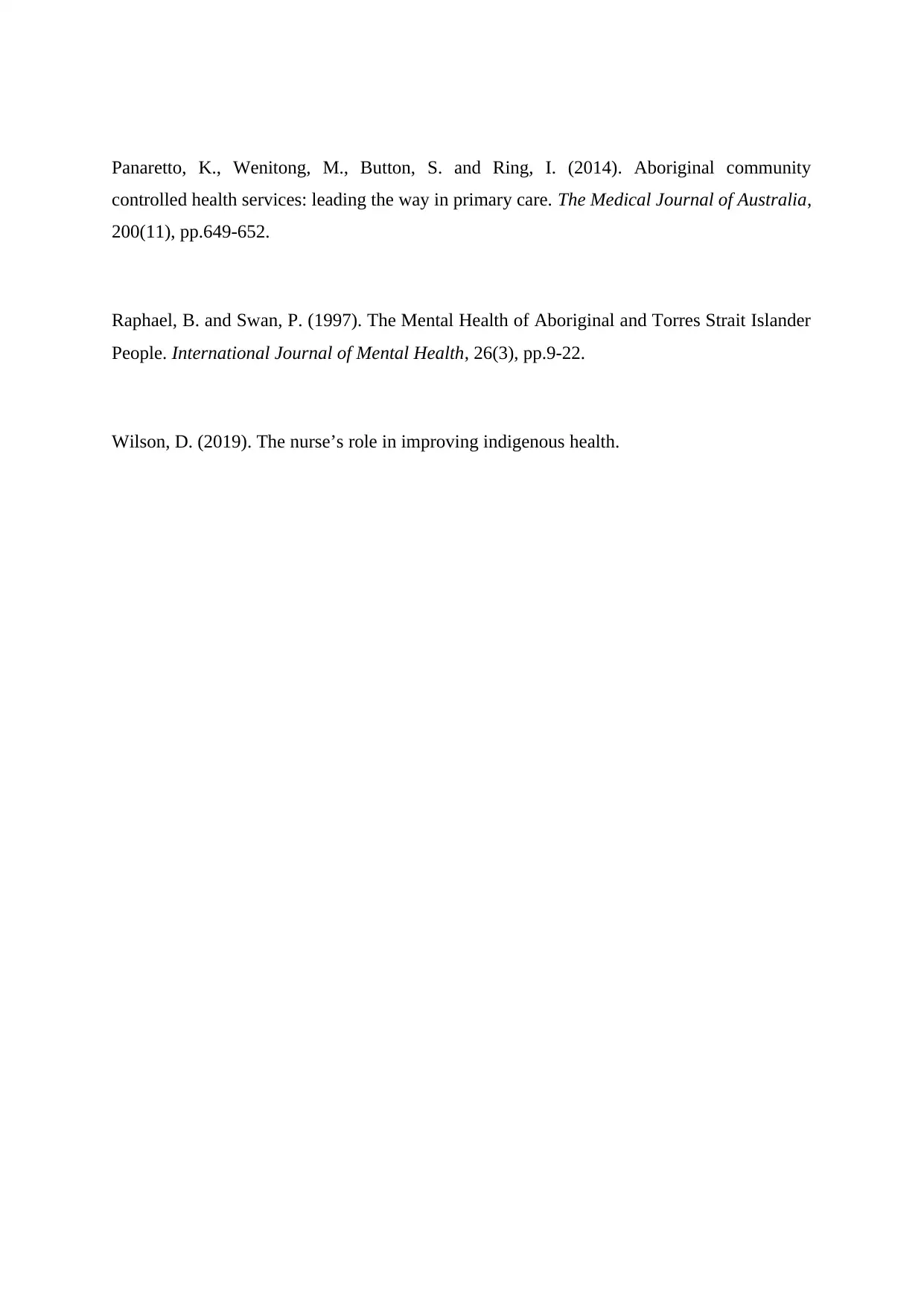
Panaretto, K., Wenitong, M., Button, S. and Ring, I. (2014). Aboriginal community
controlled health services: leading the way in primary care. The Medical Journal of Australia,
200(11), pp.649-652.
Raphael, B. and Swan, P. (1997). The Mental Health of Aboriginal and Torres Strait Islander
People. International Journal of Mental Health, 26(3), pp.9-22.
Wilson, D. (2019). The nurse’s role in improving indigenous health.
controlled health services: leading the way in primary care. The Medical Journal of Australia,
200(11), pp.649-652.
Raphael, B. and Swan, P. (1997). The Mental Health of Aboriginal and Torres Strait Islander
People. International Journal of Mental Health, 26(3), pp.9-22.
Wilson, D. (2019). The nurse’s role in improving indigenous health.
1 out of 8
Related Documents
Your All-in-One AI-Powered Toolkit for Academic Success.
+13062052269
info@desklib.com
Available 24*7 on WhatsApp / Email
![[object Object]](/_next/static/media/star-bottom.7253800d.svg)
Unlock your academic potential
Copyright © 2020–2025 A2Z Services. All Rights Reserved. Developed and managed by ZUCOL.





